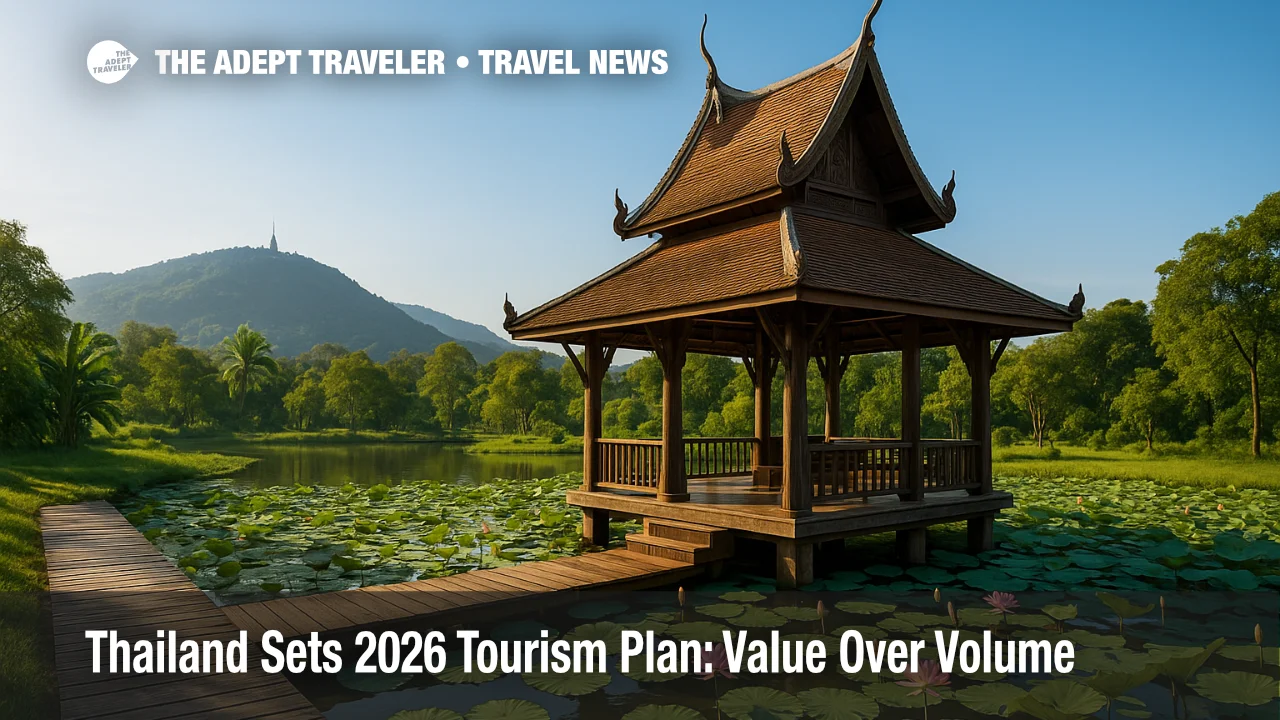Thailand Sets 2026 Tourism Plan: Value Over Volume

Thailand has unveiled a sweeping 2026 tourism strategy that puts quality and sustainability ahead of visitor headcounts. Branded "Value is the New Volume," the plan shifts the country's focus toward higher-spending, longer-staying travelers, balanced regional development, and measurable environmental standards. With a 4.5 billion-Baht government budget backing 22 initiatives, officials aim to propel Thailand into the world's top 15 tourism economies while uplifting local communities and safeguarding cultural identity.
Key Points
- Why it matters: Thailand wants lasting prosperity, not crowd-driven growth.
- Four pillars guide the plan-value, balance, creativity, and sustainability.
- New market tiers target Millennials, Gen Z, luxury, wellness, and long-stay segments.
- Domestic campaigns will spotlight UNESCO Creative Cities and emerging provinces.
- Flagship certifications and "Trusted Thailand" safety stamp launch this August.
Snapshot
By mid-2025 Thailand welcomed 18.08 million visitors and earned 1.4 trillion Baht in tourism revenue, despite a turbulent global market. Ministers now view 2026 as a reset: success will hinge on traveler satisfaction, local benefits, and ecological stewardship. Precision marketing, purpose-led storytelling, and new transport links-such as Mekong cruises and themed trains-aim to decentralize traffic away from Bangkok and Phuket toward lesser-known regions. The slogan "Healing is the New Luxury" will headline global campaigns, positioning the kingdom as a sanctuary for wellness and emotional connection.
Background
Mass tourism has long driven Thailand's economy, peaking at nearly 40 million arrivals in 2019. Pandemic lockdowns exposed the model's fragility and environmental strain, prompting a policy rethink. In 2024 the government approved a multiyear tourism reform budget and tasked the Tourism Authority of Thailand (TAT) with rewriting national strategy. Lessons from overtouristed beaches and congested heritage sites steered officials toward dispersal, higher per-trip spend, and community-owned attractions. The resulting 2026 blueprint aligns with UNESCO's Creative Cities Network, the Blue Zones sustainability pilot in Krabi, and the emerging "soft-power" push championed by cultural ministries.
Latest Developments
High-Value Markets and Soft-Power Storytelling
TAT has divided source markets into three tiers. Mature hubs-China, Hong Kong-will get safety-rebuild campaigns and secondary-city charters. Short-haul stalwarts-Malaysia, South Korea, Singapore-receive niche pushes in sport tourism and digital nomadism. Growth targets include India and Japan, while the long-haul "New Million Market" strategy courts affluent travelers from the United States, United Kingdom, France, Germany, and Russia. Communications will abandon price-driven ads for narratives of peace, wellness, and cultural resonance, reinforced by global events such as Tomorrowland Thailand 2026 and the SEA Games.
Analysis
Thailand's pivot mirrors a regional trend: Indonesia's "quality tourist" cap for Komodo, Bhutan's daily fee adjustments, and Japan's rural revitalization grants. Yet Thailand pairs rhetoric with sizable funding and clear KPIs, placing it ahead of neighbours that still equate growth with headcounts. Success hinges on execution-especially in regulatory enforcement, waste management, and equitable revenue sharing. Certifications like STGs STAR will need teeth, not plaques, to persuade discerning travelers. Furthermore, the strategy's reliance on experiential soft power must resonate across diverse cultures without diluting authenticity. If TAT synchronizes digital visa systems, green transport, and locally run experiences, the kingdom could set a benchmark for post-pandemic tourism governance. Failure would invite scepticism and reinforce perceptions of over-marketing.
Final Thoughts
"Value is the New Volume" gives Thailand a roadmap to move beyond beach-party clichés toward deeper, year-round engagement. Travelers can expect richer storytelling, safer infrastructure, and guilt-free itineraries that spread spending across the map. Communities, in turn, stand to gain from balanced footfall and upgraded standards. The next 18 months will reveal whether Thailand can transform ambition into measurable gains-and truly embed value over volume in its 2026 tourism strategy.
